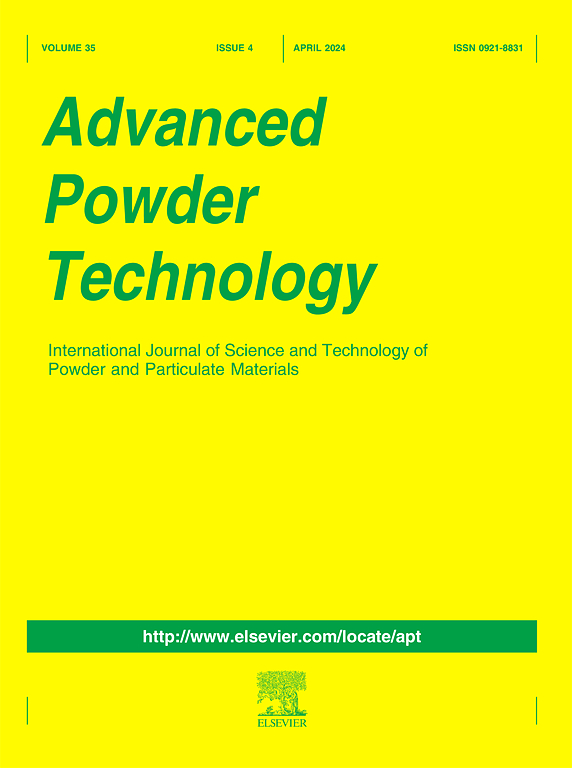双功能Ni4MoW PMEC电催化剂高效整体水分解
IF 4.2
2区 工程技术
Q2 ENGINEERING, CHEMICAL
引用次数: 0
摘要
对低成本、易合成、高效的非贵金属水分解电催化剂的追求已成为趋势。本文报道了用粉末冶金方法制备由Ni4MoW PMEC三元合金和非贵金属过渡金属组成的多孔整体式电催化剂(pmes)。该电极在浓碱性电解质中具有优异的析氢反应(HER)和析氧反应(OER)活性,在10 mA cm - 2下,析氢反应(HER)为96 mV,析氧反应(OER)为209 mV, 100 mA cm - 2下表现出优异的过电位。多孔电极在500 mA·cm-2的高电流密度下表现出优异的析氢反应稳定性,在100 mA·cm-2的高电流密度下表现出优异的析氧反应性能。此外,当Ni4MoW PMEC作为阳极和阴极时,在100 mA cm-2的高电流密度下,持续100小时的电位波动小于100 mV。这种稳定性表明电极材料在高电流条件下的稳健性,这对于水分解装置的实际应用至关重要。本研究为设计高效、低成本的多孔整体式催化剂提供了新的参考,具有很大的工业应用潜力。本文章由计算机程序翻译,如有差异,请以英文原文为准。

Bifunctional Ni4MoW PMEC electrocatalyst for efficient overall water splitting
The pursuit of low-cost, facilely synthesized, and highly efficient non-noble metal electrocatalysts for water splitting has gained momentum. This paper reports the preparation of porous monolithic electrocatalysts (PMECs) consisting of Ni4MoW PMEC ternary alloys with non-noble transition metals using the powder metallurgy method. The electrodes have excellent Hydrogen Evolution Reaction (HER) and Oxygen Evolution Reaction (OER) activity in concentrated alkaline electrolytes, showing an exceptional overpotential for the HER at 96 mV at 10 mA cm−2 and the OER at 209 mV at 100 mA cm−2. The porous electrode demonstrated excellent stability for the Hydrogen Evolution Reaction (HER) at a high current density of 500 mA·cm-2 and exhibited outstanding performance for the Oxygen Evolution Reaction (OER) at a high current density of 100 mA·cm-2. Furthermore, when the Ni4MoW PMEC was employed as both the anode and cathode, the potential fluctuation was observed to be less than 100 mV at a high current density of 100 mA cm-2 over a duration of 100 h. This stability indicates the robustness of the electrode material under high-current conditions, which is critical for practical applications in water-splitting devices. This research provides a new reference for the design of efficient and low-cost porous monolithic catalysts, which holds great potential for industrial applications.
求助全文
通过发布文献求助,成功后即可免费获取论文全文。
去求助
来源期刊

Advanced Powder Technology
工程技术-工程:化工
CiteScore
9.50
自引率
7.70%
发文量
424
审稿时长
55 days
期刊介绍:
The aim of Advanced Powder Technology is to meet the demand for an international journal that integrates all aspects of science and technology research on powder and particulate materials. The journal fulfills this purpose by publishing original research papers, rapid communications, reviews, and translated articles by prominent researchers worldwide.
The editorial work of Advanced Powder Technology, which was founded as the International Journal of the Society of Powder Technology, Japan, is now shared by distinguished board members, who operate in a unique framework designed to respond to the increasing global demand for articles on not only powder and particles, but also on various materials produced from them.
Advanced Powder Technology covers various areas, but a discussion of powder and particles is required in articles. Topics include: Production of powder and particulate materials in gases and liquids(nanoparticles, fine ceramics, pharmaceuticals, novel functional materials, etc.); Aerosol and colloidal processing; Powder and particle characterization; Dynamics and phenomena; Calculation and simulation (CFD, DEM, Monte Carlo method, population balance, etc.); Measurement and control of powder processes; Particle modification; Comminution; Powder handling and operations (storage, transport, granulation, separation, fluidization, etc.)
 求助内容:
求助内容: 应助结果提醒方式:
应助结果提醒方式:


